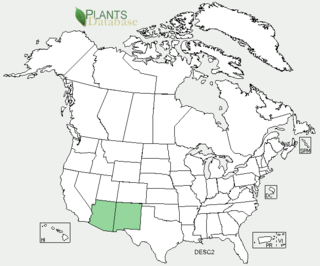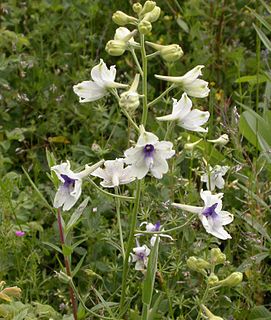
A sepal is a part of the flower of angiosperms. Usually green, sepals typically function as protection for the flower in bud, and often as support for the petals when in bloom. The term sepalum was coined by Noël Martin Joseph de Necker in 1790, and derived from Ancient Greek σκέπη (sképē) 'covering'.

Delphinium is a genus of about 300 species of annual and perennial flowering plants in the family Ranunculaceae, native throughout the Northern Hemisphere and also on the high mountains of tropical Africa. The genus was erected by Carl Linnaeus.

Hypericum is a genus of flowering plants in the family Hypericaceae. The genus has a nearly worldwide distribution, missing only from tropical lowlands, deserts and polar regions. Many Hypericum species are regarded as invasive species and noxious weeds. All members of the genus may be referred to as St. John's wort, and some are known as goatweed. The white or pink flowered marsh St. John's worts of North American and eastern Asia are generally accepted as belonging to the separate genus Triadenum.

Delphinium bakeri, or Baker's larkspur, is a species of perennial herb in the buttercup family, Ranunculaceae. It is endemic to California in the United States, where it is a federally listed endangered species. It is known in the wild from one remaining occurrence near Salmon Creek in Sonoma County, where only seven plants remained as of March 2006.

Delphinium parishii, the desert larkspur, is a flowering plant in the family Ranunculaceae native to the Mojave Desert, in the southwestern United States and northwest Mexico. In Southern California it is also found in the Tehachapi Mountains, Transverse Ranges, and eastern Sierra Nevada.

Delphinium andersonii is a species of perennial larkspur known as Anderson's larkspur. This wildflower is native to western North America, where it can be found in the Great Basin and the Sierra Nevada.

Delphinium cardinale is a species of larkspur known by the common names scarlet larkspur and cardinal larkspur. This wildflower is native to California and Baja California, where it grows on coastal, inland, and desert chaparral slopes, such as the Colorado Desert, and the Peninsular and Transverse Ranges. The presence of diterpenoid alkaloids, probably including the highly toxic methyllycaconitine, in above-ground parts of D. cardinale means that they are likely to be toxic if ingested.
Delphinium decorum is a species of larkspur known by the common names coastal larkspur and yellow-tinge larkspur. This wildflower is native to California and Oregon, where it grows on the slopes of the coastal ranges from the San Francisco Bay Area north to the southern Oregon coast. It has an erect stem which approaches half a meter in height at maximum. The leaves, which are divided into a number of narrow lobes, are mostly located about the base of the plant. The spindly stem above bears two to twenty widely spaced flowers. Each flower is carried on a pedicel several centimeters long. The five long, flat sepals are extended to give the face of the flower a star shape, and they are usually deep blue to purple. The petals are similar in color, except the top two may be lighter to almost white. The spur is very thin and may be nearly two centimeters long.

Delphinium depauperatum is a species of larkspur known by the common names slim larkspur and dwarf larkspur. This wildflower is native to western North America where it is found in mountain meadows. It grows from a short root and erects a stem usually under 40 centimeters in maximum height. The small leaves are divided into lobes and are usually located about the base of the plant. Toward the top of the stem are flowers on long pedicels, with usually not more than 20 flowers per plant. The flowers generally have deep dark blue sepals which are flat and extended to the sides, and petals which are mainly the same color except for the top two, which may be lighter blue to white. The spur is between one and two centimeters long.

Delphinium glaucum, known by the common names Sierra larkspur, mountain larkspur, and glaucous larkspur, is a species of wildflower in the genus Delphinium, which belongs to the buttercup family, Ranunculaceae. It is native to western North America from Arizona to Alaska, growing in moist mountainous environments such as riverbanks and meadows.

Delphinium hesperium is a species of larkspur known by the common name foothill larkspur. It is also sometimes called western larkspur and coastal larkspur, but these names are less specific since other species share them. It is endemic to California, where it grows in woodland and grassland in the northern half of the state. This wildflower generally reaches one half to one meter in height. It has deeply lobed, prominently veined leaves, mostly located near the base of the plant. The inflorescence may hold very few to over 100 flowers, each on a long, thick pedicel. The flowers are usually a brilliant blue or purple, and sometimes lighter pinkish to white. Often the sepals are dark in color and the petals lighter. The spur is about one to two centimeters long.
Delphinium hutchinsoniae is a rare species of larkspur known by the common names Monterey larkspur and Hutchinson's larkspur. It is endemic to California, where it is known only from Monterey County. This wildflower reaches a meter in height but is usually shorter. The leaves are divided into lobes which are further divided into smaller lobes, and they are mostly located low on the plant. The top of the thin, erect stem is occupied by an inflorescence of not more than ten flowers. Each flower has sepals which are brilliant purple or blue to lavender, two petals which are the same color, and two upper petals which are usually white. The spur is up to two centimeters long and curves down at the tip.

Delphinium nuttallianum is a species of larkspur known by the common names twolobe larkspur, Nuttall's larkspur, and common larkspur. It is widely distributed across western North America from California to Alberta, including mountain meadows and the majority of the sagebrush steppe, except very dry areas.

Delphinium parryi is a species of larkspur known by the common names San Bernardino larkspur and Parry's larkspur. This wildflower is native to Baja California and California from the San Francisco Bay Area south. It is found in chaparral and woodlands and other habitats.

Delphinium stachydeum is a species of larkspur known by the common name spiked larkspur. It is native to the Pacific Northwest and Great Basin of the United States, where it grows in sagebrush scrub and along the edges of mountain forest habitat where it meets prairie and plateau. It is a perennial herb producing at least one erect, slightly hairy stem generally exceeding a meter in height. The multilobed leaves are located mainly on the lower half of the stem except for the area just above ground level. The inflorescence is a branching array of usually more than 30 flowers, each held on a long pedicel. The flower has bright blue sepals around a centimeter long fringed with hairs and surrounding smaller, paler petals. The spur at the back of the flower is just over a centimeter in length.

Delphinium scopulorum, commonly known as Rocky Mountain larkspur, is a species of wildflower in the genus Delphinium, which belongs to the buttercup family, Ranunculaceae. It is native to the Southwestern United States and found predominantly in upper-elevation moist meadows.

Delphinium pavonaceum is a species of flowering plant in the buttercup family known by the common name peacock larkspur. It is endemic to Oregon in the United States, where it is limited to the Willamette Valley.
Delphinium viridescens is a species of flowering plant in the buttercup family known by the common name Wenatchee larkspur. It is endemic to central Washington state in the United States, where it occurs in the Wenatchee Mountains in Chelan and Kittitas Counties.
Delphinium robustum is a species of flowering plant in the buttercup family known by the common names Wahatoya Creek larkspur and robust larkspur. It is native to Colorado and New Mexico in the United States.
















